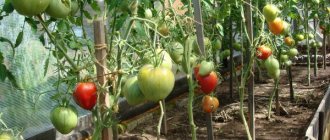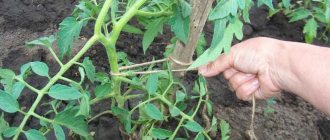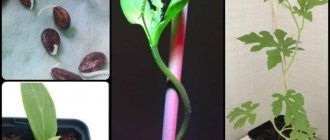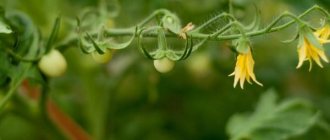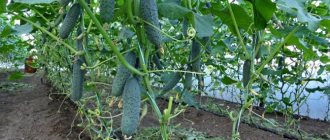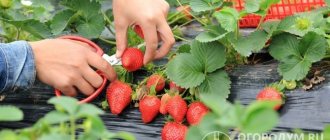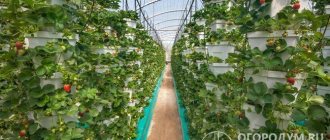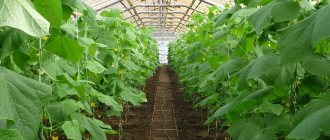In the warm regions of our country, tomato seedlings have long been pleasing with their strong and healthy appearance, and in the northern regions they were recently planted in a greenhouse due to the long and cold spring. And gardeners are feverishly refreshing their memory of the rules for caring for tomatoes after they “move” to a new place of residence.
If you also forgot them, we will try to promptly remind you. We take into account that before growing seedlings, you have previously selected tomato varieties zoned for your region.
- 17 best varieties of tomatoes for greenhouses and open ground – rating from our readers
What varieties of tomatoes are most loved by tomato growers? You will learn about this from our material.
Greenhouse or greenhouse
Many people confuse the concepts of “greenhouse” and “greenhouse”. Their main difference is that in a greenhouse the conditions for good plant growth are created artificially.
Heaters are installed in them and the humidity level is regulated. In a greenhouse, everything happens naturally, without human intervention.
Advantages of polycarbonate
Polycarbonate greenhouses are extremely widespread for growing vegetables for sale, and not just for personal use.
They differ very much and favorably from conventional ones, having a number of advantages:
- Polycarbonate can be easily given any size and shape - it can simply be cut and bent without breaking or cracking. This allows the owner of the site to build a building of almost any shape and size he needs.
- The key difference between polycarbonate and film material or glass is its good tolerance to temperature changes. Even with a sharp transition from hellish heat to icy cold, the structure will not freeze or crack, which will protect the crop from unnecessary stress.
- In addition, having built a reliable structure once, it can be used with proper simple care for about 20 years. This suggests that polycarbonate structures are extremely durable, unlike, for example, film structures, whose service life is only 2-3 years.
Greenhouse preparation
To prevent the air heated during the day from leaving the greenhouse, the following rules should be followed:
- There should be no gaps in the top layer of the greenhouse. If there are any, they are sealed with tape.
- A layer of film must be placed under the soil layer.
- The upper part is constructed not from 1, but from 2 layers with a layer of air between them.
You can warm up the greenhouse in which the tomatoes will be planted without a heater. For this you will need biofuel, it consists of the following substances:
- Food waste;
- Bird droppings;
- Fresh manure;
- Dry leaves.
The greenhouse is heated in the following sequence:
- In the fall, in the place where they plan to install a greenhouse in the spring, they dig a small pit and save the soil;
- After this, even before frost, a wooden or metal frame of the future structure is placed around the pit;
- In the spring, snow is removed from the pit, 2/3 of it is filled with biofuel, and the soil dug out in the fall is poured on top;
- The greenhouse is covered and left closed for 2-3 weeks.
Seedling
Prepared tomato seeds are planted in nutrient soil. It is most convenient to plant 1-2 grains at once in separate peat cups.
If the seedlings are planted all together, when the first true leaves appear on the stems, they are picked (planted in separate pots). This must be done very carefully so as not to damage the roots of the plants.
Using a tool, small holes are made in the beds, cups with grown and hardened seedlings are placed in them, and sprinkled with a thin layer of soil.
Tying up
Tall types of tomatoes require tying the stems to stakes. In the garden bed, pegs are installed near the stem, 25 cm higher than the plant. Next, using strips of fabric (2-3 centimeters wide), the stem is tied to them. It is not necessary to make a strong knot to make it easier to untie. As the stem grows, the first strip is removed and the plant is tied higher.
Another way of tying is to use a trellis device. This is a vertical tension of the twine followed by fixation of the tomatoes. For this method, when planting seedlings in holes, place one edge of the twine there and fix it with earth and the plant itself. Then tie the other end of the rope to the roof of the greenhouse. Already when the tomatoes grow, you should wrap the stem around the sword.
Important! Fishing line, thin thread, or wire are not suitable for tying, as such material will gradually cut into the stem, pinching it, and the plantings will die.
All tall varieties of tomatoes always require garter.
Top dressing
Seedlings are fed with special fertilizers immediately after the first leaves appear and 4-5 days before transplanting into a greenhouse.
If the plants have been picked, they are additionally fertilized immediately after the procedure and 2 weeks after that.
Immediately after planting in the greenhouse, the tomatoes are watered generously and left alone until the next watering is required, but not earlier than 3 days later.
How to plant tomatoes correctly
- The ideal time for planting is May 1-15. The date may change depending on the average daily air temperature.
- When planting, bury not only the roots of the seedlings, but also the cotyledon leaves. These will form additional roots and the plant will grow stronger.
- Planting and garter field, mulch the ground with humus or last year's leaves. Mulch will help retain moisture within the soil.
How to properly tie up tomatoes
You can tie tomatoes to stakes or stretched wire. You can drive stakes along the edges of the greenhouse, and stretch the wire between them.
For tying, you can use twine or synthetic thread. Synthetics do not rot and do not fray so quickly.
The first loop around the stem is made immediately under the first inflorescence. The taller the plant becomes, the more turns are made around it.
Main stages of growth
When the plants have established themselves in the beds, they go through several important stages, at each of which growing tomatoes in a greenhouse requires special care.
- Green period - Before flowering, tomato bushes are watered once every 5 days. As the plants grow, pinch them back. When 2 weeks have passed, the tomatoes are tied to supports.
- Flowering - In a closed greenhouse, tomatoes cannot be pollinated by insects. This procedure is carried out manually. For this inflorescence, each plant is lightly shaken and then watered. After these steps, the greenhouse must be ventilated. This will help the pollen to attach better and the humidity level will decrease. At this time, you need to pour three times more water onto each tomato bush (up to 15 liters per 1 square meter).
- After flowering - After the tomatoes growing in the greenhouse have flowered, watering is returned to normal. To ensure ripe tomatoes are firm and crispy, watering should be stopped completely two weeks before harvest.
Follow simple ventilation rules
It is better if there are vents in the upper part on both sides of the structure; warm air escapes through them faster.
To ensure optimal conditions, remember these simple tips:
- Monitor humidity and temperature indicators . If they are below the required parameters, then there is no need to open the greenhouse for a long time. An hour a day is enough.
- Consider the ambient temperature . If it is lower than what tomatoes require, then you should not open the structure so as not to overcool the plants.
- During hot periods, ensure high-quality ventilation . To prevent the plants from overheating, the greenhouse is kept open all day and closed only at night or after the air temperature has dropped significantly.
- Use suitable ventilation options . In polycarbonate greenhouses, doors or windows usually open; when purchasing, it is better to choose options with two doors or large windows; a door at one end cannot provide the normal draft needed for tomatoes. In film greenhouses, you can even lift the oilcloth or remove it altogether, if the weather permits.
- During periods of high humidity, do not open the greenhouse . This way, the likelihood of being affected by late blight is reduced significantly.
On cool days, it is better not to open the greenhouse at all.
Important parameters
To ensure that greenhouse tomatoes are tasty and disease-free, you should constantly monitor the following important parameters:
- Each time after weekly watering, the greenhouse must be ventilated for several hours. This is necessary to ensure that the humidity level does not rise too high. Tomatoes grown in too humid an environment turn out sour and watery.
- Temperature. In the daytime, the temperature in a panic should fluctuate between 24-26 degrees, and at night should not fall below 18. The temperature can be reduced by ventilation, and raised by using biofuel.
- Stepsonning. Tomato bushes need to be pinched and pinched regularly. Each bush should have from 1 to 3 stems. All other shoots must be removed. The same applies to excess or too small flowers and ovaries.
- Lighting. A greenhouse is usually placed in an open area of the site, where the sun will constantly shine on it. If technical capabilities allow, additional fluorescent lighting can be installed in the greenhouse. This will significantly speed up plant growth.
Planting and growing tomatoes in a greenhouse allows you to grow a good harvest regardless of weather conditions. And building a structure and caring for plants inside a greenhouse is not at all difficult.
Some care tips
Gardeners have a lot of questions about caring for tomatoes: flowers fall, leaves curl, and so on. Of course, if for some reason the growth of a tomato is disrupted and suspended, then this is primarily reflected in the formation of the plant and inflorescence, that is, few fruits are formed on the flower cluster, and this sharply reduces the yield.
If the plant is fattening
For example, if a tomato has constantly curled upper leaves, rapid growth, and the plant itself is powerful, the stems are thick, the leaves are dark green, large, juicy , that is, as gardeners say, it is fattening, then such a plant will not produce a harvest, since everything goes into the vegetative mass, into the greenery. Such plants, as a rule, form a very weak flower raceme with a small number of flowers. This happens from abundant watering when applying large doses of nitrogen and organic fertilizers and lack of light .
How to straighten such plants? First of all, you need to not water them for 7–10 days, increase the temperature for several days during the day to 25–26°C, and at night to 22–24°C (do not open doors or windows in the greenhouse). It is also necessary to properly pollinate the flowers of these plants, that is, from 11 a.m. to 1 p.m., hand shake the flower brushes in warm, dry weather. To delay growth, root fertilize with superphosphate (for 10 liters of water you need to take 3 tablespoons of superphosphate) at the rate of 1 liter for each plant. And in a short time the plants are corrected.
If flowers and fruits fall
It happens that the leaves of plants are directed upward at an acute angle and do not curl either at night or during the day. Flowers and even small fruits often fall off on such . The reason for this is dry soil, high temperature in the greenhouse, poor ventilation, low light. In this case, it is urgent to water the plant, reduce the temperature in the greenhouse, ventilate, etc.
Conversely, in well-developed plants, the upper leaves curl slightly during the day and straighten out at night, the flowers do not fall off, they are bright yellow, large, and there are many of them in the flower raceme. This means that the plant receives everything it needs for growth: light, nutrition, etc. From such plants they get a good harvest.
If fruits do not grow on the second and subsequent clusters
It often happens that beautiful large fruits are poured on the first cluster, but the filling is slow on the second and third clusters . In order to speed up the filling of fruits on the second and third flower clusters and improve the flowering of subsequent ones, it is necessary to remove the first harvest from the first cluster as early as possible, without waiting for the reddening of the fruits. The picked brown fruits ripen quickly on a sunny windowsill (literally in two days).
In addition, immediately after harvesting, it is necessary to water the soil at the rate of 10–12 liters of water per 1 m2. Stepchildren and leaves are not cut off; the temperature in the greenhouse must be reduced to 16–17°C (open the windows and doors), especially at night. Under these conditions, the crop quickly forms on subsequent clusters and ripens at an earlier date.
If the plants are thin, weakened
Sometimes in a good new greenhouse, gardeners have thin plants with long internodes, a loose flower cluster and a small amount of fruit . What's the matter?
- Lack of lighting. Perhaps there are trees or berry bushes growing around the greenhouse, and the lighting inside the greenhouse is low. As a result, the yield is 3–4 times lower than in a greenhouse well lit by the sun. Therefore, remember that tomatoes are the most light-loving crop. From the sun and the fruits are sweet.
- Lack of nutrients in the soil.
